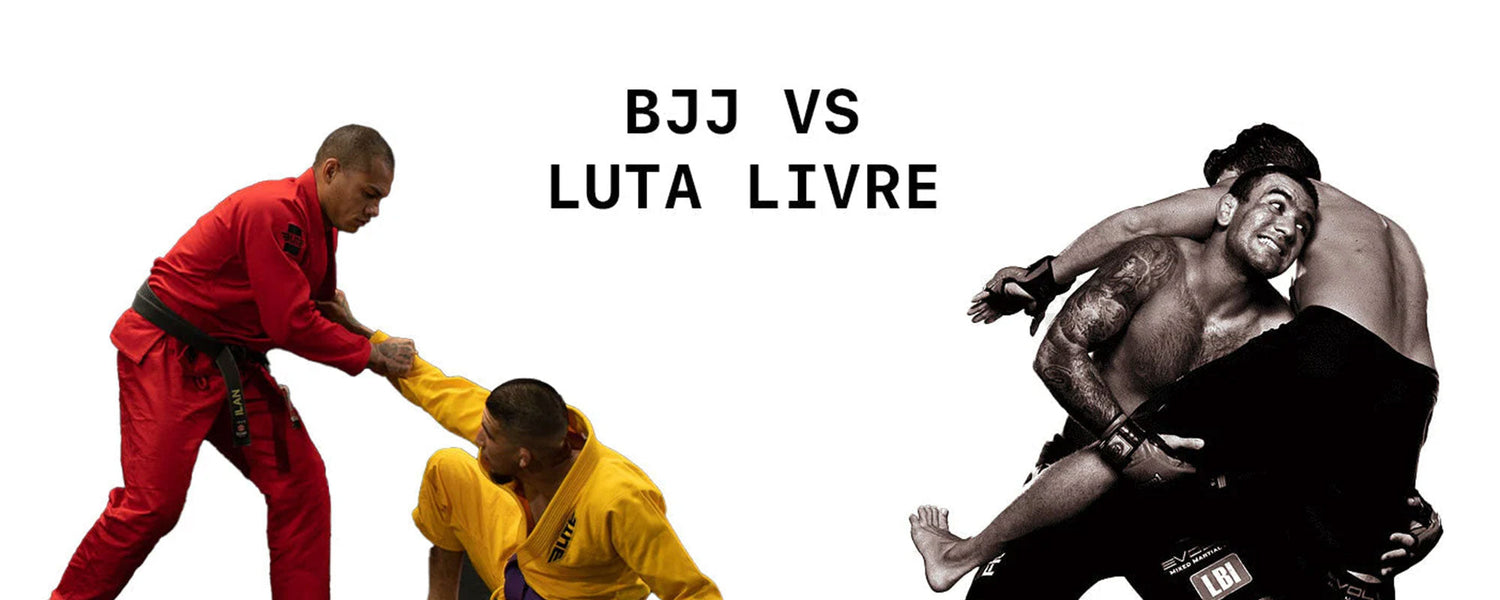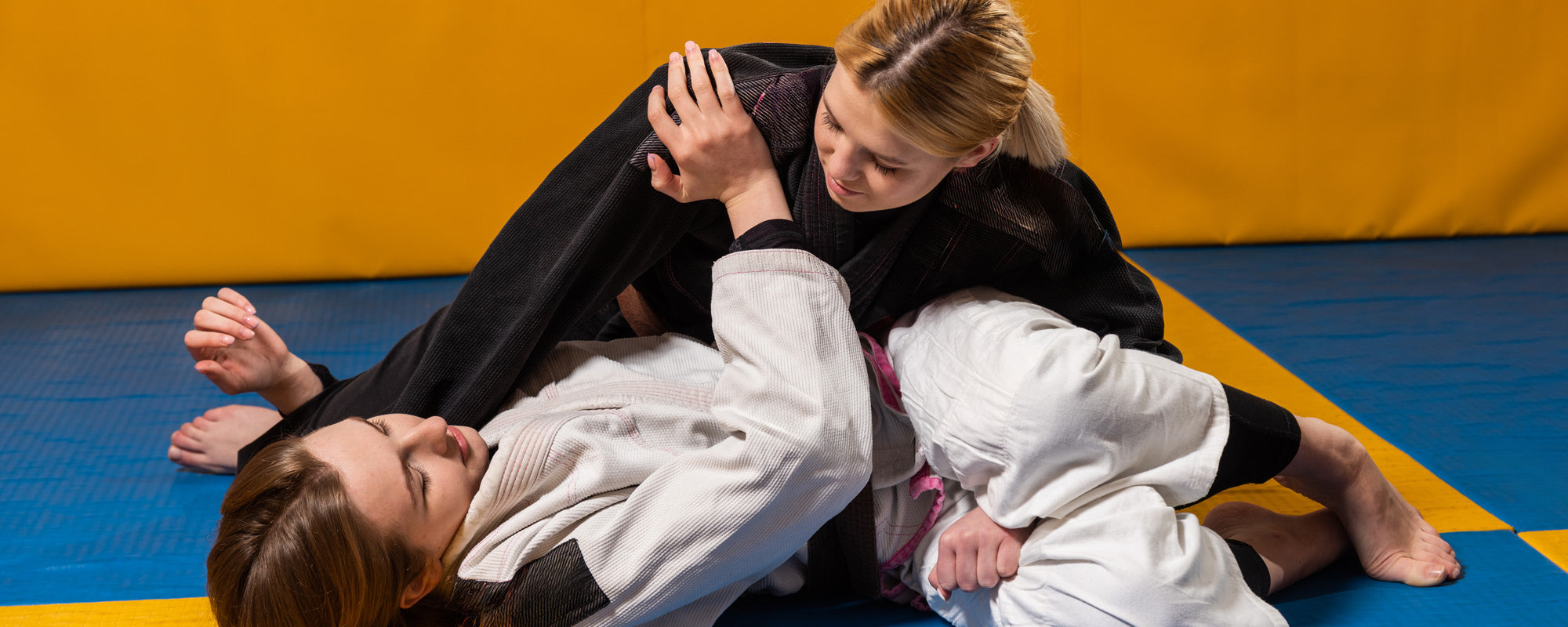Table of content
1. Luta Livre and BJJ - Introduction
1.1. Luta Livre and BJJ meaning
BJJ, also pronounced as Brazilian Jiu-Jitsu or jiu-jitsu, means “gentle art.” “Luta Livre Esportiva,” also known as Luta Livre, is the Portuguese word for “freestyle fighting.” Both names briefly define what the two martial arts are. The main difference between BJJ and Luta Livre is the type of gi used (the uniform BJJ practitioners wear). Luta Livre is more like no-gi BJJ that includes techniques not used in BJJ like strikes.
1.2. Luta Livre and BJJ Origins

Luta Livre and BJJ both emerged from Rio De Janeiro, Brazil. BJJ is a Brazilian adaptation of Japanese jiu-jitsu. The Gracie brothers learned jiu-jitsu from Mitsuyo Maeda, a BJJ fighter in the early 1900s. Drawing inspiration from Japanese jiu-jitsu, the Gracie brothers created the version of BJJ known today.
Luta Livre was created by Euclydes Hatem, also known as Mestre Tatu. Hatem fought against George Gracie in 1940, winning the match by subduing George Gracie. This gave a boost to Luta Livre’s reputation during the 1940s to 1980s.
Luta Livre has two major forms: Esportiva and Vale Tudo. Esportiva resembles no-gi BJJ, utilizing techniques similar to those used in catch wrestling and submissions. Meanwhile, Vale Tudo is currently used in MMA and includes both strikes and submissions.
2. Luta Livre and BJJ - History
The Gracie family was considered a very wealthy family in Brazil. Their fighting style was targeted toward rich people who could afford a gi, an expensive piece of clothing during the early days of BJJ. While Luta Livre was a freestyle fighting style that did not require a gi, it became popular amongst the ordinary folks of Brazil.
2.1. First Conflict Between Gracie and Naja
Charlie Gracie and Mario Duma, a Thai boxer, had an argument that eventually lead to a fight. Charlie was defeated by a much older opponent of Naja Academy. In an interview, Eugênio Tadeu, a famous Luta Livre practitioner, said that the argument was over a woman.
The older members of the Gracie family didn’t take this loss lightly. They gathered a group of BJJ fighters and went to the Mau Thai academy that Duma represented. There, they challenged their senior member Mario Duma and defeated him. That was an embarrassing moment for the Naja Academy (a Muay Thai academy).
2.2. 3 vs 3 Fight Between BJJ and Naja Practitioners
To resolve this enmity, Robson Gracie held a three vs three competition between Naja Academy fighters and BJJ practitioners. During the matches, Marcelo Behring (a BJJ practitioner) defeated Flavio Molina (Naja Fighter), and Eugênio Tadeu (Naja) defeated Renan Pitanguy (BJJ) and Marcos Ruas (Naja) held the match draw again heavyweight BJJ fighter (Fernando Pinduka). According to eyewitness accounts, the BJJ fighters were favored by the referees, and the competition ended in a draw. However, whatever the real truth is, this event damaged the reputation of BJJ and Gracie Academy.
2.3. Beach Fight Between Rickson Gracie and Hugo Duarte in 1988
According to locals, Rickson Gracie planning to go out of Brazil for vacation or business purposes, but before going, he wanted to restore the Gracie family’s reputation. So Rickson stepped forward and challenged Hugo Duarte, who was considered to be the champion of Luta Livre at the time. But Duarte refused to fight because according to him, he needed four months to prepare himself for the fight. But Rickson wanted to fight as early as possible because he wanted to leave Brazil soon. Rickson finally decided to confront Duarte in public. Rickson somehow learned that Duarte visited Pepe Beach daily. Finding Duarte, Rickson arrived on the beach and challenged him right there and then. According to eyewitness accounts, Rickson instigated the fight by slapping Duarte.
Duarte gave up after being mounted several times by Rickson. Duarte was not satisfied with the results. In an interview, according to Duarte, sand was thrown into his eyes by one of the pro-BJJ onlookers. Despite these claims, this event badly affected the reputation of Luta Livre. As a result, Duarte began planning to take revenge on the Gracie family.
2.4. Invasion of Luta Livre on Gracie Academy in 1988
Hugo Duarte gathered almost 60 people and went to invade Gracie Academy. There was also a rumor that the 60 people had knives and weapons. However, Helio Gracie was present at the academy and stopped the invasion; he even handled the situation diplomatically by convincing Rickson Gracie to fight Duarte. The fight was set in the parking lot near the academy. Rickson again won the match, but this time Duarte was satisfied with the results.
After this event, BJJ once again began to prosper as a highlight of national and international martial arts competitions.
2.5. Three BJJ Fighters vs Three Luta Livre Fighters, 1991
In 1991, a contest was held between three BJJ fighters and three Luta Livre fighters. The competition was actually a result of a statement said by Wallid Ismail, in which he said that Luta Livre was a bad copy of jiu-jitsu. This statement was written by the newspaper O Dia in April 1991. This statement caused outrage among Luta Livre fighters. Once again, they invaded Gracie Academy and the situation was handled again by Helio Gracie. To settle the matter, a competition was held between jiu-jitsu and Luta Livre fighters.
This challenge caught the interest of one of the TV companies known as Rede Globo. Robson Gracie was the organizer. Initially, the rules used were the same as used for grappling. However, the rules were later changed to a no holds barred competition.
The competition had the following matchups:
- Wallid Ismail (from BJJ) vs Eugênio Tadeu (from Luta Livre)
- Fábio Gurgel (from BJJ) vs Denílson Maia (from Luta Livre)
- Murilo Bustamante (from BJJ) vs Marcelo Mendes (from Luta Livre)
The BJJ fighters won every single match. This event resulted in a major boost in BJJ’s popularity and hence, a huge number of students applied to BJJ academies. However, the bad blood between BJJ and Luta Livre's practitioners did not end.
2.6. Renzo Gracie vs Eugênio Tadeu, 1997
In 1997, an event referred to as Pentagon Combat was held. This event was sponsored by Abu Dhabi’s Sheikh Tahnoon who recently became interested in no holds barred fighting. The match was fought between Renzo Gracie and Eugênio Tadeu. Renzo had been present at Pepe Beach when Rickson and Hugo Duarte fought. And he had some unresolved issues with Luta Livre.
The match had a large audience, being broadcast across the world. However, the match was interrupted because Renzo told the MMA management staff that he was kicked by someone outside the cage when both fighters were in a corner of the cage. When Renzo retaliated, a mass crowd came forward and broke the walls of the cage. A riot broke out, destroying the whole place, with locals claiming that guns were being fired as well.
This event made international news; even CNN reported this incident. After that, no holds barred fighting was banned from competitions in Rio de Janeiro.
Now Luta Livre has been largely absorbed into Vale Tudo fights. Meanwhile, BJJ is still practiced in MMA and growing under the Gracie name.
3. Luta Livre and BJJ – Differences
3.1. Outfit/Uniform
In BJJ, practitioners wear a uniform known as a BJJ gi, the traditional garb of jiu-jitsu. A BJJ gi includes a cotton jacket, pants, and belt. The belt has specific colors that represent the rank of the fighter. These colors are: white, blue, purple, brown, black, and red. The gi also contributes to applying certain techniques, like the gi choke, arm triangle, etc. A gi also helps absorb sweat, ensuring practitioners apply their techniques firmly without slippery hands.
Meanwhile, in Luta Livre, the practitioners do not wear a traditional uniform. They just simply wear shorts. This helps ensure that you cannot be easily grabbed by your outfit.
3.2. Giving Space to Your Opponent
In BJJ, the practitioner does not give the opponent much space to move. A BJJ practitioner tries to occupy as much space as possible, especially when grabbing the opponent, so the opponent remains trapped in such a way that the opponent cannot move or escape.
However, in Luta Livre, the practitioners leave space for their opponents to move. They do so to maneuver the opponent into a favorable position so they can effectively apply their techniques to choke outer try to make the opponent submit. For example, if a Luta Livre practitioner wants to choke the opponent by the neck but the opponent has left no space for him to do so, then the Luta Livre practitioner pretends there is no danger to the opponent’s neck. As the opponent leaves the space around the neck open, the Luta Livre practitioner applies a neck choke.
3.3. Leverage or Movement
In BJJ, practitioners tend to use leverage to control, move, or sweep the opponent. In BJJ, the concept of leverage is to use the joints and limbs of the body as levers, applying minimum effort while gaining maximum results.
In Luta Livre, the practitioner focuses more on movement. If the opponent tries to block, Luta Livre practitioners try to create space so that there is more room to move, giving them the opportunity to escape.
3.4. BJJ and Luta Livre – Belt Colors:
In BJJ, the belts are white, blue, purple, brown, red, and black. The time it takes to move up between belt ranks can vary from student to student. Typically, it can take years to be promoted. The time it takes to jump from white belt to blue belt can range from one to three years. But again, the time it takes to be promoted varies from student to student depending on the number of times a students train per week. As the time interval is long between belt ranks in BJJ, stripes are used to indicate the progress students are making.
In Luta Livre, the belts are white, yellow, orange, blue, purple, brown, and black. Practitioners are usually promoted to the upper belt ranks within the period of one to one and a half years, depending on how frequently practitioners train per week.
3.5. BJJ and Luta Livre – Rules
In BJJ, the International Brazilian Jiu-Jitsu Federation (IBJJF) has recently changed the rules. Heel hooks and ankle locks that involve wrapping the leg are allowed for brown and black belts. Lower body submissions are not allowed if you are below the brown belt. This isn’t usually an issue since most BJJ practitioners do not attack the legs.
In Luta Livre, ankle locks are allowed even for white belts. Then, as practitioners climb up the rank they are allowed to utilize heel hooks and foot kimuras. Heel hooks are forbidden unless you are a blue belt.
3.6. BJJ and Luta Livre – Standing Position
In BJJ, practitioners start in a standing position but their main priority is to take the opponent down to the ground. Usually, a BJJ fighter lay down while their opponents remain on top. They try to grab their opponent and choke them in a laying position. As there are no strike techniques in BJJ, taking the ground position helps BJJ fighters defend themselves. BJJ practitioners usually don’t attempt to pass the guard.
In Luta Livre, the practitioners try to fight in a standing position. One of the main reasons for remaining standing is because striking is allowed in Luta Livre. Luta Livre practitioners try to take the opponent down and stay on the top position, trying to keep their neck and shoulder away from the opponent’s grasp. They usually try to choke the opponent with their knee rather than choking them with their elbow. Luta Livre practitioners learn and apply more techniques to try and pass the guard.
3.7. BJJ and Luta Livre – Strategy
In BJJ, practitioners usually try to grab the opponent from behind and try to apply a chokehold so the opponent submits. In most cases, you will see BJJ practitioners fight while sitting down, whether they are pulling the guard, trying to sweep, guard passing, mounting, attacking from the back, or applying a submission. There are other ways to do BJJ techniques, but in most cases, the practitioner will be sitting down.
In Luta Livre, practitioners prefer to fight in a standing position while trying to make the opponent submit. They try wrestling first to take the opponent down while remaining on top. Staying on top gives practitioners more manoeuvrability and options during combat. For example, if the practitioners are in control, they can press the advantage; if the practitioners feel they are in danger, they can always step back. They are able to go for the neck, legs, arms, or feet to make their opponent submit.
3.8. BJJ and Luta Livre – Most Studied Positions
In BJJ, practitioners most often work on defending against guard passes and preventing being taken from behind. They try to defend first, sweep, and then submit. They also usually try to maintain or take back the mount from any position.
While in Luta Livre, the practitioner’s main objective is to try and pull off a submission from any position possible. It is difficult to study every specific position that every Luta Livre practitioner can do. Practitioners should always switch to the position that will help them best pull off a submission.
3.9. BJJ and Luta Livre – Submissions
In BJJ, practitioners most often work on leg triangles, armbars, omoplatas, and gi chokes for submission techniques.
While in Luta Livre, practitioners commonly use guillotines, arm triangles, attacks to the legs, attacks to the ankle or the knee, and kimuras.
4. Conclusion
After reviewing their history, it is evident that BJJ won the war against Luta Livre. One of the main reasons for that is the amount of money the Gracie family put into keeping BJJ alive. The Gracie family limited BJJ lessons to the wealthy people at first because normal people could not afford a BJJ gi. This bias gave birth to Luta Livre which did not have the limitation of requiring a gi, allowing anyone to learn it.
Luta Livre is seen as a combination of grappling, vale tudo, wrestling, and jiu-jitsu. Luta Livre is also still considered the no-gi version of BJJ by certain circles. Currently, BJJ techniques are more popular among fighters compared to Luta Livre. while Luta Livre is seen more in Vale Tudo.
Photo Credit: @pngitem













Leave a comment
This site is protected by hCaptcha and the hCaptcha Privacy Policy and Terms of Service apply.